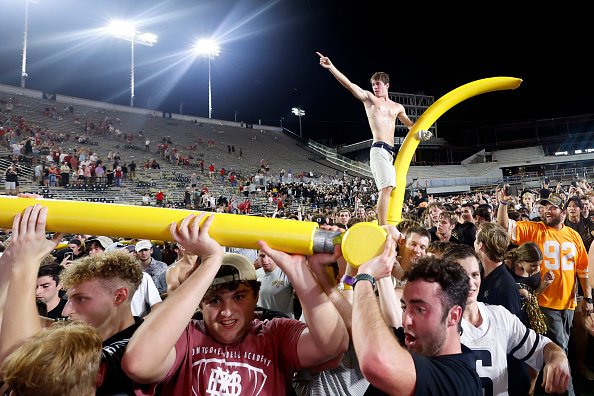Vanderbilt's goal post teardown follows a football tradition that's led to litigation from injured fans

Vanderbilt Commodores fans march the goal posts around the field following a game between the Vanderbilt Commodores and Alabama Crimson Tide on Oct. 5, 2024, at FirstBank Stadium in Nashville, Tennessee. (Photo by Matthew Maxey/Icon Sportswire via Getty Images)
On Saturday, Vanderbilt University’s Commodores football team did the unimaginable: It defeated the No. 1-ranked, three-touchdown-favorite University of Alabama Crimson Tide.
Delirious Vandy fans celebrated the win over college football’s perennial Goliath by storming the field of FirstBank Stadium in Nashville, Tennessee, tearing down a goal post and carrying it three miles before depositing it in the Cumberland River.
Surprisingly, there were no reports of serious injuries during the trek fans took carrying the 30-foot-tall, nearly 20-foot-wide and several-hundred-pound uprights through the streets of the Music City. Local media reported that two police officers suffered unspecified injuries and two Nashville Fire Marshal vehicles were damaged.
But unscathed is not always how the tomfoolery turns out. Serious injuries have occurred when exuberant football fans engaged in the time-honored revelry of making goal posts a trophy of a significant or improbable win. Some of those harmed have sought to lay blame and seek compensation. In several such cases, it took referees in black robes to sort it out.
In 1985, following a New England Patriots win, Pats fans celebrated by carrying a portion of a goal post outside the stadium. The aluminum structure came into contact with a high-voltage overhead electric power line. Jon Pallazola was injured while trying to prevent the electrified goal post from falling on him.
Pallazola settled with the stadium security company for $4.5 million. Massachusetts’s highest court, in Pallazola v. Town of Foxborough (1994), concluded that the town was off the hook based on governmental immunity. Specifically, a Bay State statute shielded the municipality from failure to provide adequate police protection.
The court rejected Pallazola’s argument that the statute should not apply because among other reasons, the town derived financial benefits from the operation of the stadium.
In 2003, fans, including Joseph Moening, stormed the field following a football game at the University of Toledo. The home team Rockets had just taken down the Pittsburgh Panthers. While a throng of revelers was attempting to remove a goal post, the crossbar broke free, trapping Moening. He was knocked unconscious, and his lower back was injured.
The Ohio Court of Claims, in Moening v. University of Toledo (2006), decided that Moening could not recover damages. Despite his contention that he never heard the announcement warning fans to stay off the field, the court concluded that that didn’t matter.
He left the seating area, climbed over a railing and slid down a more than six-foot concrete wall. Simply put, that was enough for the court to reach the conclusion that Moening “knowingly and consciously placed himself in close proximity to the goal post with utter disregard for the obvious risk of harm he was exposed to from the actions of an unruly crowd.”
In 2001, Andrew Bourne was paralyzed from the waist down after a goal post, torn down by celebrating Ball State fans, fell on him. The university invited fans to rush the field and tear down the structure. After settling with the school for $300,000—the statutory cap—Bourne set his sights on the goal post manufacturer, which had been in that business since 1960.
Examining the history of goal post design and construction, efforts to make them more difficult to tear down and the manufacturer’s knowledge of what celebratory fans had previously done to its product, the Indiana federal court, in Bourne v. Marty Gilman, Inc. (2005), held that even if there were designs available to make stronger goal posts, Bourne assumed the risk of an injury that was obvious.
“Bystanders on the scene,” the court stated, “saw a 40-feet tall structure of metal pipes with a dozen or more adults climbing on it and bouncing and rocking it back and forth with the obvious intent to cause it to fall.” An appeals court affirmed.
Margaret Cimino was seriously injured when she was struck by a goal post being pulled down at the conclusion of the 1983 Harvard-Yale game. Among other issues, the Connecticut federal court, in Cimino v. Yale University (1986), determined that the City of New Haven might not be precluded from liability despite being a municipal actor.
A jury would have to determine if an exception to governmental immunity, for injuries caused by the actions of a “mob, riot, or assembly of persons engaged in disturbing the peace,” applied.
Jurors would also have to determine if the city’s pregame plan for protecting the goal posts, such as the number of officers assigned, their location and tactics, were adequate.
At the risk of sounding like a cranky get-off-my-AstroTurf-guy, there were wiser ways for Vanderbilt fans to celebrate slaying Alabama than tossing a goal post into the tide.

Randy Maniloff is an attorney at White and Williams in Philadelphia and an adjunct professor at the Temple University Beasley School of Law. He runs the website CoverageOpinions.info.



